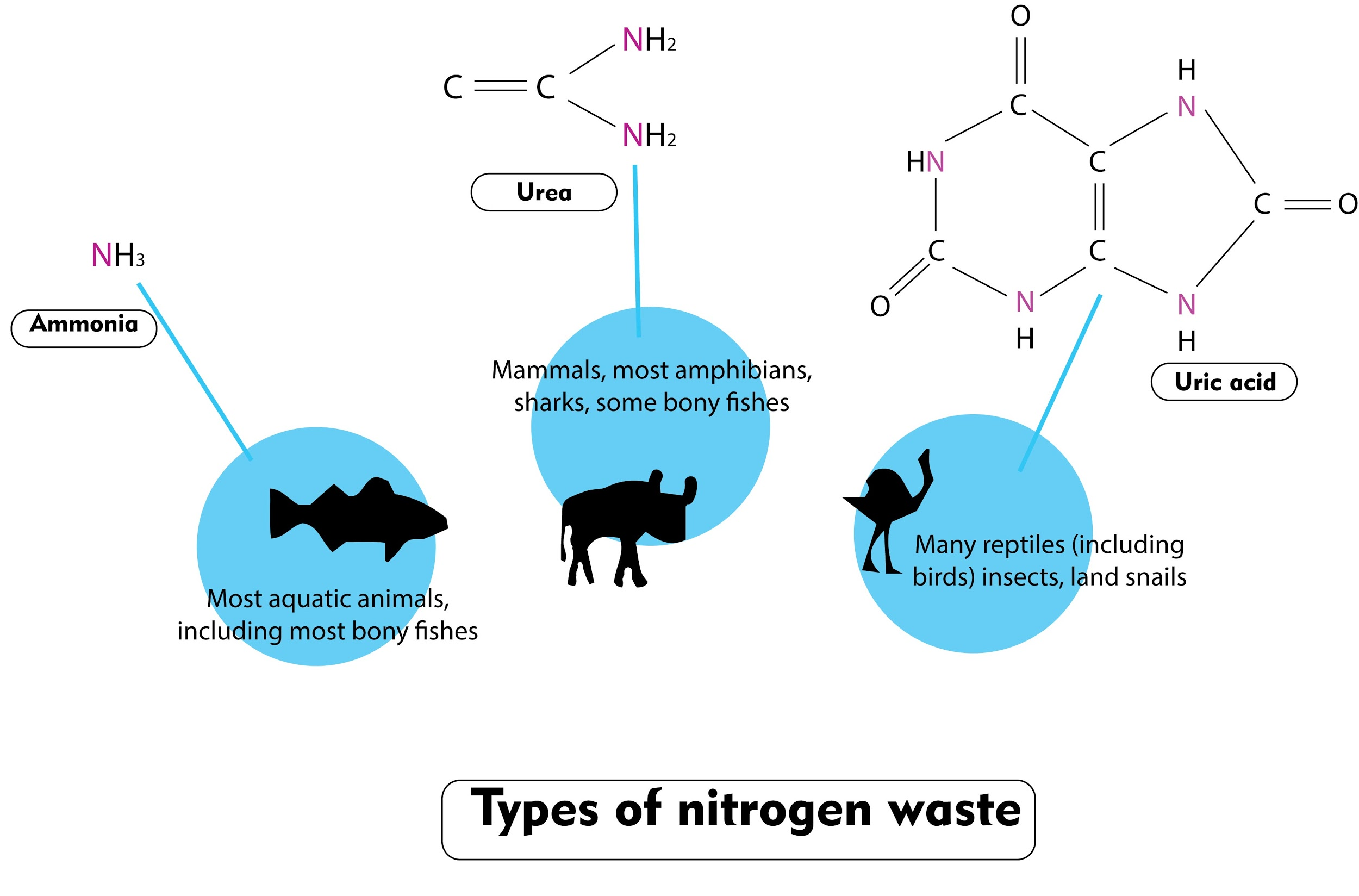
The characteristics that are shared by urea, uric acid, and ammonia is/are
(A) They are nitrogenous wastes.
(B) They all need a very large amount of water for excretion.
(C) They are all equally toxic.
(D) They are produced in the kidney.
(a) Both (A) and (C)
(b) Both (A) and (D)
(c) (A), (C) and (D)
(d) (A) only
Answer
573.6k+ views
Hint: These are nitrogen compounds through which excess nitrogen is eliminated from the body of the organisms in the form of wastes. This process of elimination involves many organs meant to carry the same function.
Complete answer:
The characteristics that are shared by urea, uric acid, and ammonia is that they are nitrogenous wastes. Nitrogenous wastes include ammonia, uric acid, and urea. All the different types of metabolic wastes are excreted in the form of water solutes through the excretory organs such as nephridia, Malpighian tubules, and kidneys, except for $CO_ 2$. The carbon dioxide is excreted together with the water vapor throughout the lungs. The elimination of these compounds such as ammonia, uric acid, and urea enable the chemical homeostasis of the organism.
- All of the nitrogenous wastes are produced from protein metabolism. The ammonotelism is the process of excretion of ammonia and ammonium ions. When proteins are converted into carbohydrates the $NH_3$( ammonia) is formed by the oxidation of the amino group. $-NH_2$.
- Ureotelism means the excretion of urea. In terrestrial animals, such as amphibians and mammals, the ureotelism occurs in the liver and kidney, it converts ammonia into urea. These animals are called ureotelic.
- Urea is a less toxic compound than ammonia, where two nitrogen atoms are eliminated through it and less water is needed for its excretion.
- The excretion of excess nitrogen in the form of uric acid is uricotelism. Uricotelic animals include insects, birds, and most reptiles show uricotelism.
So, the correct answer is, ’(d) (A) only’.

Note:
- The condition of optimal functioning for the organism includes many variables, like blood heat and fluid balance, being kept within certain pre- set limits is called homeostasis.
- Uric acid requires more metabolic energy to form as compared to urea, thanks to low toxicity and low solubility in water allows it to be concentrated into a little volume of pasty white suspension.
- In many animals, the urine is that the main route of excretion for such wastes, or in some animals, it's the feces.
Complete answer:
The characteristics that are shared by urea, uric acid, and ammonia is that they are nitrogenous wastes. Nitrogenous wastes include ammonia, uric acid, and urea. All the different types of metabolic wastes are excreted in the form of water solutes through the excretory organs such as nephridia, Malpighian tubules, and kidneys, except for $CO_ 2$. The carbon dioxide is excreted together with the water vapor throughout the lungs. The elimination of these compounds such as ammonia, uric acid, and urea enable the chemical homeostasis of the organism.
- All of the nitrogenous wastes are produced from protein metabolism. The ammonotelism is the process of excretion of ammonia and ammonium ions. When proteins are converted into carbohydrates the $NH_3$( ammonia) is formed by the oxidation of the amino group. $-NH_2$.
- Ureotelism means the excretion of urea. In terrestrial animals, such as amphibians and mammals, the ureotelism occurs in the liver and kidney, it converts ammonia into urea. These animals are called ureotelic.
- Urea is a less toxic compound than ammonia, where two nitrogen atoms are eliminated through it and less water is needed for its excretion.
- The excretion of excess nitrogen in the form of uric acid is uricotelism. Uricotelic animals include insects, birds, and most reptiles show uricotelism.
So, the correct answer is, ’(d) (A) only’.

Note:
- The condition of optimal functioning for the organism includes many variables, like blood heat and fluid balance, being kept within certain pre- set limits is called homeostasis.
- Uric acid requires more metabolic energy to form as compared to urea, thanks to low toxicity and low solubility in water allows it to be concentrated into a little volume of pasty white suspension.
- In many animals, the urine is that the main route of excretion for such wastes, or in some animals, it's the feces.
Recently Updated Pages
Why are manures considered better than fertilizers class 11 biology CBSE

Find the coordinates of the midpoint of the line segment class 11 maths CBSE

Distinguish between static friction limiting friction class 11 physics CBSE

The Chairman of the constituent Assembly was A Jawaharlal class 11 social science CBSE

The first National Commission on Labour NCL submitted class 11 social science CBSE

Number of all subshell of n + l 7 is A 4 B 5 C 6 D class 11 chemistry CBSE

Trending doubts
Differentiate between an exothermic and an endothermic class 11 chemistry CBSE

10 examples of friction in our daily life

One Metric ton is equal to kg A 10000 B 1000 C 100 class 11 physics CBSE

Difference Between Prokaryotic Cells and Eukaryotic Cells

State the laws of reflection of light

Explain zero factorial class 11 maths CBSE




